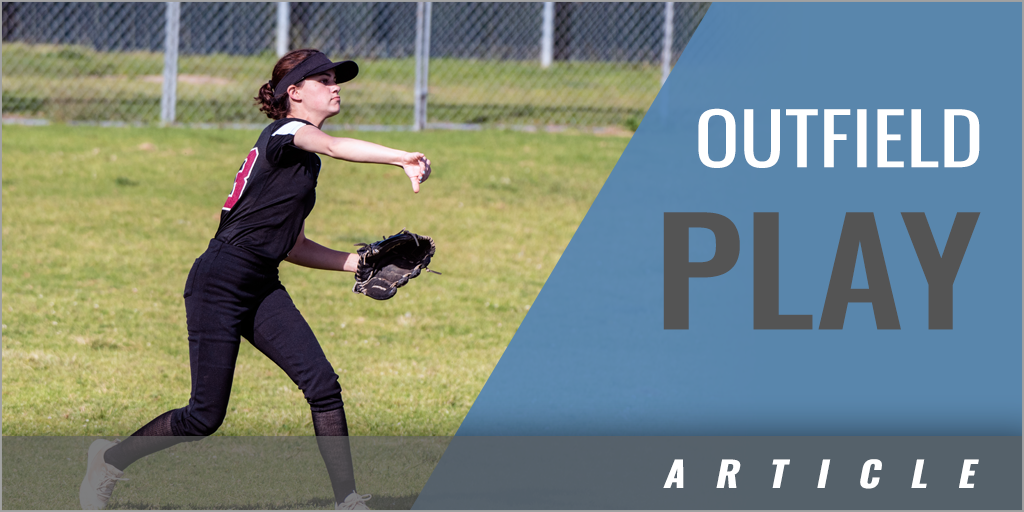|
By: Bill Gray and Melissa Chmielewski Originally Published in: Practice Perfect Softball - NFCA Provided by: Human Kinetics Outfield play can be broken down into several vital areas - speed, arm strength, ball recognition, angles, and aggressiveness. The first two are the easy ones. We ask outfielders to cover the most ground and make the longest throws, so speed to cover ground and arm strength to throw the ball to the plate are important. But can they get to the ball in such a way to set themselves up to make that throw? When they get there will they have the determination to make the play that is necessary? Do you remember back in high school and college when you said, "Why do I have to learn math or geometry when I will never use it?" Well, guess what, it rears its ugly head in the outfield. Angles and acceleration are important in the outfield. Players have to judge the ball off the bat to know what angle to take and how fast to travel so that they can meet the ball at the proper point, stop it, and then change its direction and apply enough force to reach another point in time to put out an advancing runner. Translation: Get to the ball and be in proper position to throw it to the next player, who must make a tag or relay it. Speed is a must in the outfield. Or is it? If an athlete takes the proper angle to the ball and gets a good jump, speed is a bonus, not a necessity. The outfielder's first step is the most important one because it sets the angle to the ball. The drop or open step is important. The outfielder should drop the foot and open the hips to a 45-degree angle on the side the ball is hit and gain ground so that the second step also gains ground on the ball. On a ball over her head, she should travel 4 to 6 feet (1 to 2 m), depending on size and age, from where she began. When she pursues the ball, her glove should remain tucked until she reaches for it at the last second. Many younger outfielders want to extend their arm and run, thinking the ball is going to fall into it. This technique slows them down and negates any chance of making a catch. Use tennis balls without gloves for drop step drills and then progress to gloves and game balls. Lastly, after the athlete catches the ball, she should stop immediately and turn over her glove shoulder to throw the ball. Diving Diving is a teachable skill, but the athlete who does not hesitate is a true outfielder. On the other hand, you have to make sure that your outfielders dive as a last-ditch effort, not just to dive. Most outfield plays can be made by running through the ball and catching it at its lowest point, but when those efforts will not get it done an outfielder has to dive. We use both the headfirst dive and a feet-first slide for our outfielders. When attempting a headfirst dive, the athlete must remember to extend both hands as if she is diving into a pool. If she keeps the throwing hand under her, she runs the risk of injury when the weight of her body and momentum hit the ground. She should try to land more on her chest; the knees should be the last thing to hit the ground. A sliding dive allows the outfielder to pop up quickly and make a throw. This method is effective with a runner at third. The player uses a basic figure-four slide and secures the ball at about waist level. Diving can be taught inside on gym pads with athletes starting on their knees and falling forward. At full extension, they attempt to catch a ball that is tossed to them. Do forehand, backhand, and straight on. Then move to standing. They usually have to take a step and then dive. Finally, have them sprint and dive onto the mat. After they are comfortable with diving on mats, go outside. Use the same progression. Relays When the outfielder is deep or the ball is hit over her head, she may require a relay to get the ball to the base. She needs to understand that she is throwing the ball through the relay person, not to her or over her. The throw should be head high when it reaches the relay person, making her decision to cut off the ball or let it go much easier. Balls need to be lasers, not rainbows. The looping throw that gets to the plate may not be a good throw if there was no play at the plate and runners advanced behind the ball. Backups An outfielder should never grow roots in one spot. Just like an infielder, she should move on every pitch. If the ball is put in play, she needs to back up either the play, a potential throw, or possibly a second throw. You have to pay attention to this at practice because it will pay off in a game. Give the outfielders assignments on every play. Praise them when they back up a play that is made ahead of them. That one time when the play is not made and they are there to back up, you will be thankful. The backup should be deep enough to make a play on a deflection or overthrow. If the outfielder is too close to react to either, she might as well have stayed in her original position. Make sure to show her the proper depth in practice and the result if she is too close to the play. Defense does not just happen. This part of the game entails repetition after repetition. Skills should be broken down and perfected, but there is nothing like a few hundred ground-ball or fly-ball repetitions to build confidence and perfect skills. Make a list of situations and practice them or at least discuss them so that your athletes are prepared to be successful when the time comes. |







